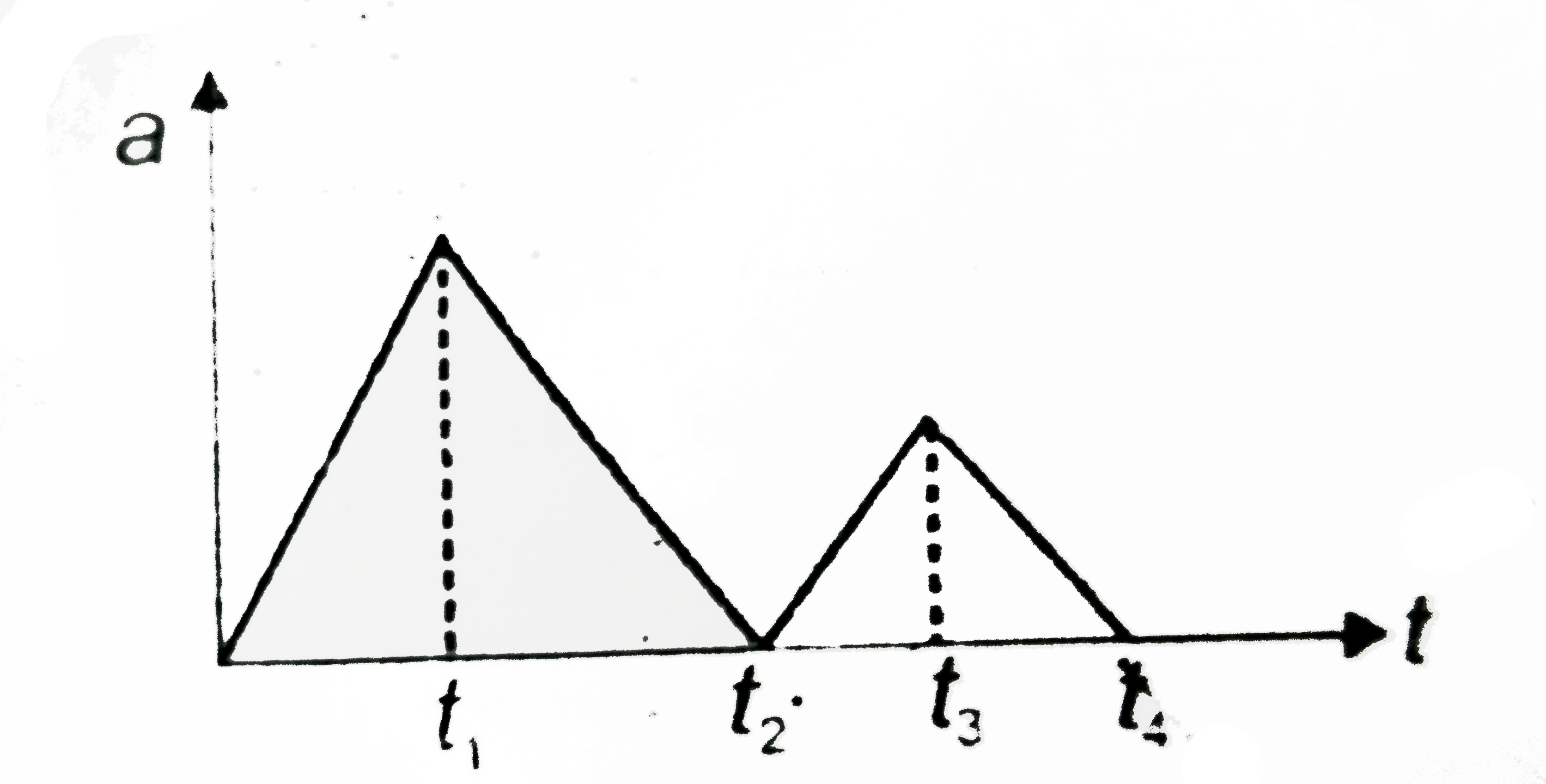A point mass starts moving in a straight line with a constant acceleration a. At a time t1 a fter the beginning of motion, the acceleration changes sign, remaining the same in magnitude. Determine the time t from the beginning of motion in which the point mass returns to the initial position.
√2t
(2+√2)t
t√2
Cannot be predicted unless acceleration is given
The correct Answer is:B
In this problem, point starts moving with uniform acceleration a, after time t (position B) the direction of acceleration get reversed i.e. the retardation of same value works on the point. Due to this velocity of points goes on decreasing and at position C it’s velocity becomes zero. Now the direction of motion of point reverse and it moves from C to A under the effect of acceleration a. We have to calculate the total time in this motion. Starting velocity at position A is equal to zero.
Velocityatposition=B rArr v = at<br><imga≤ocr_imageload∈g=lazysrc=https://d10lpgp6xz60nq.cloudfront.net/physics_images/NP_2023_PHY_V01_C02_E01_089_S01.pngwh=80%mx-autosty≤=background:white;><br>DistancebetweenAandB,S_(AB) = 1/2 at^2<br>Assameamountofrηrdationworksonap∮anditcomes→rest∴<br>S_(BC) = S_(AB) = 1/2 at^2<br> therefore S_(AC) = S_(AB) + S_(BC) = at^2andtimerequired→coverthisdistanceisalsoequal→t.<br>TotaltimetakenformotionbetweenAandC=2t<br>Nowforthereturnjour≠yomC→A(S_(AC) = at^2)<br>S_(AC) = ut + 1/2 at^2 rArr at^2 = 0 + 1/2 at_1^2 rArr t_1 = sqrt2 t<br>Hence→taltime∈whichp∮returns→∈itialp∮<br>T = 2t + sqrt2 t = (2+sqrt2) t
Topper's Solved these Questions
- BOOK - ERRORLESSCHAPTER - MOTION IN ONE DIMENSIONEXERCISE - NCERT BASED QUESTIONS (RELATIVE MOTION )18videos
MOTION IN ONE DIMENSION
- BOOK - ERRORLESSCHAPTER - MOTION IN ONE DIMENSIONEXERCISE - NCERT BASED QUESTIONS (MOTION UNDER GRAVITY )56videos
MOTION IN ONE DIMENSION
- BOOK - ERRORLESSCHAPTER - MOTION IN ONE DIMENSIONEXERCISE - NCERT BASED QUESTIONS (UNIFORM MOTION )24videos
MOTION IN ONE DIMENSION
- BOOK - ERRORLESSCHAPTER - KINETIC THEORY OF GASES EXERCISE - ASSERTION AND REASON16videos
KINETIC THEORY OF GASES
- BOOK - ERRORLESSCHAPTER - MOTION IN TWO DIMENSIONEXERCISE - ASSERTION & REASON19videos
MOTION IN TWO DIMENSION
Similar Questions
A point mass starts moving in a straight line with constant acceleration. After time t0 the acceleration changes its sign, remaining the same in magnitude. Determine the time T from the beginning of motion in which the point mass returns to the initial position.
View SolutionA particle is moving in a circular orbit with a constant tangential acceleration. After a certain time t has elapsed after the beginning of motion, the between the total acceleration a and the direction along the radius r becomes equal to 45∘. What is the angular acceleration of the particle.
View Solution
Knowledge Check
- Question 1 - Select One
A point mass starts moving in straight line with constant acceleration a from rest at t=0. At time t=2s, the acceleration changes the sign remaining the same in magnitude. The mass returns to the initial position at time t=t0 after start of motion. Here t0 is
A4sB(4+2√2)sC(2+2√2)sD(4+4√2)s - Question 2 - Select One
A body moving in a straight line with constant acceleration covers distances a and b in successive equal time interval of t. The acceleration of the body is
Aa+bt2Bb−at2C2b−a2t2Db−2at2 - Question 3 - Select One
A particle is moving in circular path with constant acceleration. In time t after the beginning of motion the direction of net acceleration is at 30∘ to the radius vector at that instant. The angular acceleration of the particle at that time t is
A3t2B1t2C√3tD√3t2
A particle starts moving from rest on a straight line. Its acceleration a verses time t is shown in the figure. The speed of the particle is maximum at the instant
 View Solution
View SolutionA point moves along a circle with a velocity v=t/2. Find the acceleration of the point at the moment when it has covered a quarter circle from the beginning of motion.
View SolutionA particle of mass m is moving along the line y-b with constant acceleration a. The areal velocity of the position vector of the particle at time t is (u=0)
View SolutionA particle starts moving with a constant angular acceleration in a circular path. The time at which the magnitudes of tangential and radial acceleration are equal is
View SolutionA point mass moves along a circle of radius R with a constant angular acceleration α. How much time is needed after motion begins for the radial acceleration of the point mass to be equal to its tangential acceleration ?
View Solution

